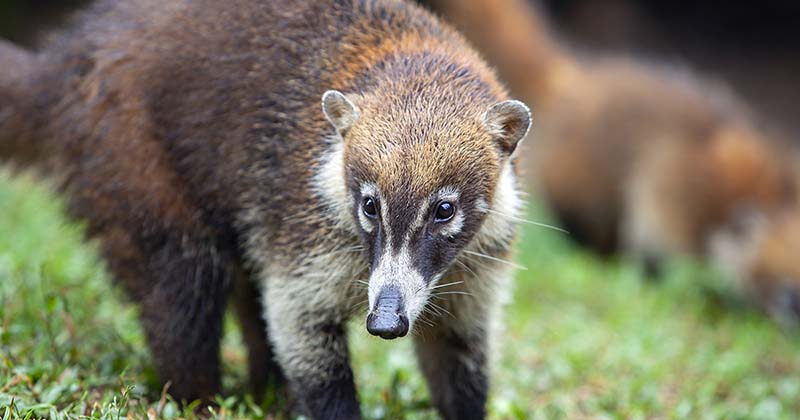Who among us in Texas has not shared a tale (possibly a tall one) of a jaguarundi sighting? Whether a first-hand account or a retelling of what a nearby rancher swears he saw, these elusive wild cats, native to the Americas, have captured our imagination. But what about another undi? The coatimundi, more commonly known as the white-nosed coati, shares a similar range to the jaguarundi, from the south and central Americas to northern Mexico, and occasionally across the border into Texas. But that’s where the similarities end. Although rare in Texas, the white-nosed coati does not—at least yet—share the jaguarundi’s similar mysterious allure. But maybe it should.
What is a white-nosed coati?
These raccoon and ringtail cousins are members of the Procyonidae family. White-nosed coatis weigh between 8 and 16 pounds and sport dark rings around their tails which they hold upright when walking around. Unlike the possum’s tail, the coati tail is not prehensile, but it is used to maintain balance in trees like a squirrel’s.
A white muzzle on an elongated, upturned nose explains the white-nosed coati’s name. This utilitarian snout allows the coati grub for insects, while five toes with heavy foreclaws are designed for digging. White-tailed coatis also eat rodents, lizards, fruits (including prickly pear), and nuts. Like humans and bears, coatimundi are plantigrade—they walk on the soles of their feet. Ringtails and raccoons tend to be solitary and nocturnal, but these stripe-tailed relatives are very social and active during the day. Their social nature is demonstrated by a communal lifestyle as described by the New Mexico Department of Game and Fish:
“Coatis live in groups, called bands or troops. These can number from three to over twenty animals! Troops usually consist of adult females, most of which are related, and their young. These troops split up in early summer, when the females are about to give birth, usually to 2-6 young. When the young are about 2-3 weeks old, the troops reunite…When two troops meet, there is much sniffing, grunting and squealing as they greet each other. Sometimes, coatis from one troop will leave with the other one!”
White-tailed coatis live 5-7 years in the wild and up to 14-20 years in captivity.
Where is the white-nosed coati in Texas?
There are four species of coatis—white-nosed, brown-nosed, the mountain coati, and a coati found only on San Cozumel Island—but only the white-nosed coati may be found in Texas, if only rarely. The coati is listed as “threatened” by Texas Parks and Wildlife Department but, as described by Texas Tech’s Natural Science Research Laboratory, “recent sighting in the Padre Island and Big Bend areas suggest that coatis may be making a comeback in the state.”
According to information provided to Texas Tech by Rob Dean, a naturalist and park ranger, there have been “about 35 sightings of coatis over the past 50 years in Big Bend National Park.” The most recent update from the school being “8 sightings during 2005-2015.” Further, the school reports, John Karges, a naturalist with the Texas Nature Conservancy, “provided information about contemporary sightings from other places outside the park, including the canyon country adjacent to the park and along the Devil’s River drainage, the Davis Mountains, and from Maverick County in southern Texas. Given all of these records, it is surprising more specimens have not been obtained, but the available information seems to indicate that coatis are more common and widely distributed than previously thought.
White-tailed coati as pollinator
Although not happening in Texas, a particularly interesting fact about white-nosed coatis is that they’re pollinators of the balsa tree. In a study conducted in Costa Rica, coatis were observed sticking their noses into flowers of the tree to drink the nectar which also covered their faces with pollen. Per the study: “Scientists observed a dependent relationship between the balsa tree, which provides a critical resource of hydration and nutrition to the white-nosed coati when environment resources are scarce, and the coati, which increases proliferation of the tree through pollination.”
With its sleek, wild cat appearance and solitary, secretive ways, the jaguarundi will probably always be the elusive star—the whopper of a wildlife story told ‘round a crackling fire. Long, bug-grubbing snouts and pollen-covered faces that squeal when they meet other troops may not be as provocative and alluring, but the next time someone tells of a jaguarundi sighting in Texas, with a tilt and nod of the head try this: “very interesting, but have you seen a coatimundi?”









